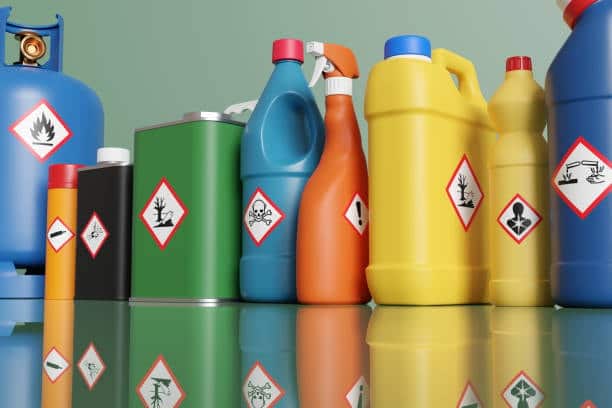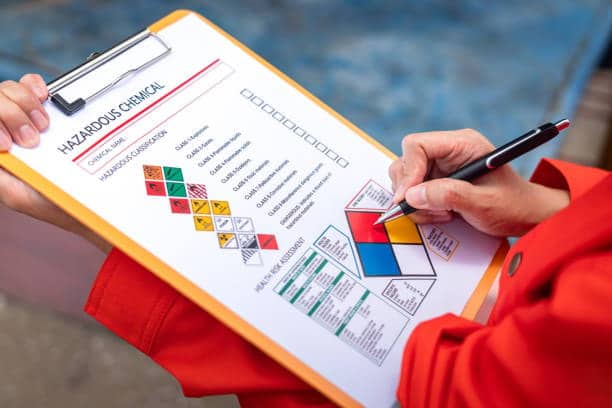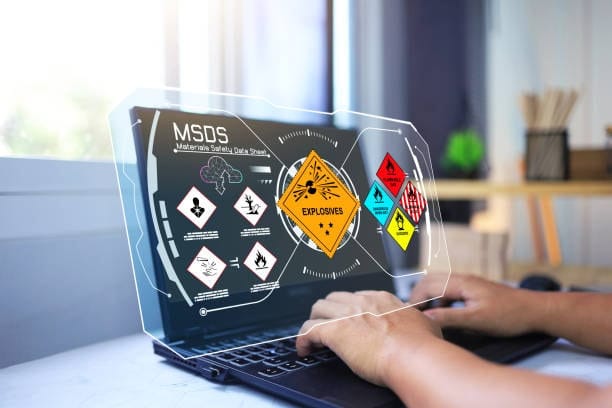Modern business activities depend heavily on dangerous goods transportation because it connects healthcare operations to manufacturing businesses and energy sectors. Different products which include flammable liquids and toxic substances create serious danger when improperly managed. Declaration of dangerous goods certificate works as an essential tool which guarantees people and businesses maintain the ability to address these security risks competently. The article examines dangerous goods training and certificates through their significant role in regulatory requirements and certification procedures while explaining all aspects of safety and compliance.
What Are Dangerous Goods?

During shipment dangerous goods which people commonly name hazardous materials or hazmat include substances and articles that have the potential to threaten human health and safety along with property and environmental well-being. Two major categories exist for dangerous goods — those considered explosive and flammable gases and those classified as corrosive chemicals and radioactive materials as well as lithium batteries or aerosol cans. These materials need additional care since they present leakage and ignition risks as well as potential harm during transit when subjected to movement-related changes.

Properties of dangerous goods are consistently standardized worldwide by following the guidelines set in the United Nations Recommendations on the Transport of Dangerous Goods. All dangerous products fall under nine hazard categories including Class 1 Explosives as well as Class 3 Flammable Liquids and Class 6 Toxic and Infectious Substances. Specific handling along with packaging and labeling requirements apply to every class of dangerous goods thus requiring personnel who can recognize these distinctions through recurrent training.
The Role of a Dangerous Goods Certificate

A formal document grants authorization for individuals who received training in the proper documentation and handling procedures for hazardous materials based on official regulations. This document serves simultaneously to authorize workers who have undergone initial and recurrent training ile creating safety measures for public protection. Risks of accidents including spills fires or explosions become significantly higher when business operations lack certified personnel which results in possible life loss environmental damage or severe legal consequences.

The certificate does not offer uniformity in its qualifications to individuals. The certification depends on both transport method (air, sea, road or rail) alongside the individual set of governing regulations. Air transport operates under dangerous goods regulations from the International Air Transport Association (IATA) known as DGR whereas sea transport uses the International Maritime Dangerous Goods (IMDG) Code. National regulatory bodies control road and rail transport with standards that include DOT HMR in the United States and the Canadian TDG Act.
Why Certification Matters

A dangerous goods certification stands as an essential requirement for many reasons. Above all else the certificate provides safety protection for operations. Individuals with professional training from a dangerous goods certification course understand to identify potential hazards and select proper packaging which reduces emergency situations and protects against incidents. A certified worker knows that flammable liquids require safe containment equipment to stop fires yet toxic substances need ventilation solution with protective equipment for safety.
Compliance is another critical factor. Different authorities mandate thorough regulations that control shipping training and dangerous goods transportation across national and international scales. Noncompliance leads to potential fines together with shipment rejections and legal actions. The standards compliance process leads to certificate issuance that safeguard the organizational reputation while delivering financial advantages.

The process of certification provides businesses with access to professional growth prospects as well as safety and regulatory adherence benefits. Professionals from logictics and aviation and shipping sectors show preference for certified candidates because they want these individuals to handle more complicated roles or receive better salary benefits. The public trusts businesses that have certifications because it indicates the company upholds its responsibilities towards the public interest.
Regulatory Frameworks Governing Dangerous Goods

A series of interconnected regulations controls dangerous goods transport while being synchronized at different levels between national borders. The United Nations establishes the regulatory framework through its Model Regulations that both classifies dangerous materials and specifies basic safety standards for their handling. The recommendations undergo adaptations from international bodies and national governments before they become suitable for specific transport modes and regional requirements.
The IATA DGR stands as the main reference for air transport operations since its annual updates consolidate current safety protocols in accordance with the ICAO Technical Instructions. The year sees more than 1.25 million dangerous goods shipments transported through air routes so this framework has become essential. The International Maritime Organization (IMO) operates the IMDG Code as the authoritative standard that controls sea transport operations dedicated to marine conditions. The U.S. DOT’s 49 CFR together with Canada’s TDG Regulations maintain domestic safety alongside ensuring harmonization between international borders.

Member companies within these frameworks must receive training alongside certification but follow different system requirements. The training requirements established by IATA demand recertification every two years but DOT requires periodic re-training to take place once every three years. Anyone desiring a dangerous goods certificate should learn the packing instructions o differentiate between these regulations.
Types of Dangerous Goods Certificates

Dangerous goods certificates exist in different versions depending on both transportation method and job role to match the complete range of activities in this field. Below are the primary types:
IATA Dangerous Goods Certificate

The dangerous goods certificate operates as a mandatory qualification which serves all personnel within freight transport including shipping companies freight forwarders and members of airline staff operations. The certificate provides training about IATA DGR which includes the proper shipping name and rules for air shipment classification together with packaging and documentation requirements and labeling procedures. Educational material includes the current version of the DGR manual before students take an exam.
IMDG Certificate

The certificate targets maritime transportation while following the rules established in the IMDG Code. Protocol training teaches people the proper ways to handle dangerous goods on ships through stowage practices alongside segregation and sea emergency response procedures. Shipping companies together with port workers need this training as a matter of necessity.
TDG Certificate (Canada)
Any personnel in Canada who work with dangerous goods must receive training under the TDG Regulations which involves handling or offering transport or movement by road rail and inland waterways. The certificate demonstrates mastery of Canadian regulations and many employers or accredited providers issue it to their candidates.
DOT Hazmat Certification (U.S.)
The US DOT HMR regulates this certification within road transport and rail transport and domestic air transport operations. The training program comprises three components: overall safety knowledge and specialized area education combined with safety systems specific to U.S. requirements.
ADR Certificate (Europe)
European Agreement Concerning the International Carriage of Dangerous Goods by Road (ADR) controls all road transport throughout Europe. The certificate becomes vital for both drivers and logistics employees who gain mastery over hazard classes and security standards of vehicles.

These specific types of certification equip their designated professionals to handle exclusive challenges that align with their work duties.
The Certification Process

To become certified in dangerous goods operations, one must follow particular steps according to the provider and the regulation they use, including options for online dangerous goods training. Here’s a general overview:
Step 1: Identify the Relevant Training

People ought to begin by selecting the qualification that matches their role alongside their transportation method. People preparing air cargo need IATA training but European truck drivers must receive ADR certification. Organization needs determine how employers decide which certificate their employees will use.
Step 2: Enroll in a Training Program

The training can be accessed through accredited providers or completed through online platforms and in-person education. IATA provides cargo training through authorized instruction centers where students can complete self-paced lessons and classroom-based programs. The training curriculum includes lessons on hazards together with packaging requirements and emergency preparedness offered through an online course .
Step 3: Complete the Course
The duration of training courses depends on the difficulty level with minimum durations spanning from a few hours up to multiple days. Students interact with official documentation together with study cases and hands-on instructional material within the program training is required. An IATA certification requires study of the latest version of the DGR manual for successful evaluation.
Step 4: Pass the Assessment

The conclusion of most programs uses written or online or practical tests to demonstrate competency. Trainees need to achieve minimum scores of 80% or higher according to IATA standards while IATA certificates remain valid for 24 months and DOT certificates are valid for three years rules and regulations course provides.
Step 5: Maintain Certification

The process of recertification becomes essential because new regulations continue to evolve. The duration of refresher courses remains shorter than basic training steps to sustain safety awareness together with compliance requirements training course online training.
Key Skills Acquired Through Certification

A dangerous goods certificate enables handlers to develop vital skills which ensure safe efficient transport operations.
- Certificate holders learn how to classify goods into nine UN classes as well as assign packing groups with high danger being PG I while low risk items belong to PG III.
- Accurate packaging methods alongside appropriate hazard labels protect goods from improper handling while allowing people to quickly identify potential risks.
- Accurate shipping papers including the Shipper’s Declaration for Dangerous Goods receive the necessary mastery required by law.
- The emergency response protocols enable people to respond quickly to spills and fires and exposures to minimize potential destruction.
- Compliance with global and local standards becomes possible by understanding regulatory frameworks such as IATA DGR and IMDG Code.
The combination of these abilities creates a system that decreases potential hazards while boosting operational system performance.
Challenges in Obtaining and Maintaining Certification

The journey to get a dangerous goods certificate along with its subsequent retention requires significant obstacles to overcome. The demanding regulatory environment requires heavy commitment to complex rules including those for limited quantities, as well as constant learning about newest updates. IATA DGR requires annual updates to which certified individuals need to adapt by learning about modified packaging requirements and limited item lists dangerous goods by air.

Cost is another hurdle. Businesses especially those with limited funds may find it challenging to afford training expenses coupled with materials purchases like DGR manuals and employees need to be absent from work duties. The accessibility of training options changes because rural workers experience difficulties finding nearby instructors but online education has helped solve this problem.
Maintaining certification demands discipline. Organizations experiencing delays in recertification process may lose validity of their credentials which leads to operational disturbances passenger or cargo aircraft. The successful integration of these difficulties needs dedication from workforce members and business leaders.
Benefits Beyond Compliance

The advantages of a dangerous goods certificate extend beyond meeting legal mandates. For individuals, it boosts employability in high-demand sectors like logistics and aviation, often leading to higher salaries or leadership roles based on their job function iata dangerous goods training . Employers benefit from reduced liability, as certified staff lower the risk of accidents and fines. Insurance premiums may also decrease, reflecting a safer operation list of dangerous goods.
Environmentally, proper handling prevents spills or emissions that could harm ecosystems. Public safety improves as well, with fewer incidents threatening communities near transport routes due to effective safety training ship hazardous materials
. These broader impacts highlight the certificate’s role in sustainable and responsible commerce.
Industry Applications

The certification of dangerous goods provides essential value for various business sectors since it applies throughout multiple industries.
- IATA certification enables airlines and cargo handlers to employ staff who securely manage air shipment transportation.
- Shipping lines together with ports employ IMDG-trained personnel to manage navigation of sea transport risks during operations.
- Logistic organizations depend on certified personnel under DOT and ADR standards to execute road transportation and storage functions at their warehouses and trucks.
- Laboratories together with hospitals need skilled workers who hold TDG or IATA certification to transfer infectious material.
- Certified individuals from energy companies handle all transportation movements of dangerous substances including oil and gas products as well as chemicals.
The versatility of this certificate becomes apparent through each individual sector.
The Future of Dangerous Goods Certification

Dangerous goods certification continues to transform itself in several ways. The training approach known as Competency-Based Training and Assessment (CBTA) which IATA and ICAO support directs their focus towards teaching career-specific crucial skills instead of memorization course covers. Employers need to develop specialized training programs under this method for achieving better results in dangerous goods certification.

Technology is also transforming certification. Online education systems also provide a dangerous goods course with adaptable learning models which integrate virtual reality technology for practical training experiences. Educational institutions may use digital certificates alongside systematic verification procedures iata dangerous goods regulations. World trade expansion presents both opportunities for global standard unification to help simplify international regulatory requirements while national regulatory systems are expected to remain different.

Sustainability is another emerging focus. The future training will include steps to eliminate harmful packaging options and use low-emission transportation as part of worldwide environmental targets.
Conclusion
The dangerous goods certificate operates as both a vital safety and compliance requirement and a professional advancement tool when handling hazardous materials for transport. Such skills and knowledge enable handlers to protect health, property and the environment which supports global economic industries. The benefits derived from obtaining a dangerous goods certificate exceed all expenses and difficulties associated with certification which makes it mandatory for all candidates seeking professional growth within the industry shipping dangerous goods. The dynamic nature of certification will enable its adaptation to emerging global risks and chances that manifest from evolving regulations and technologies in our interconnected world.




